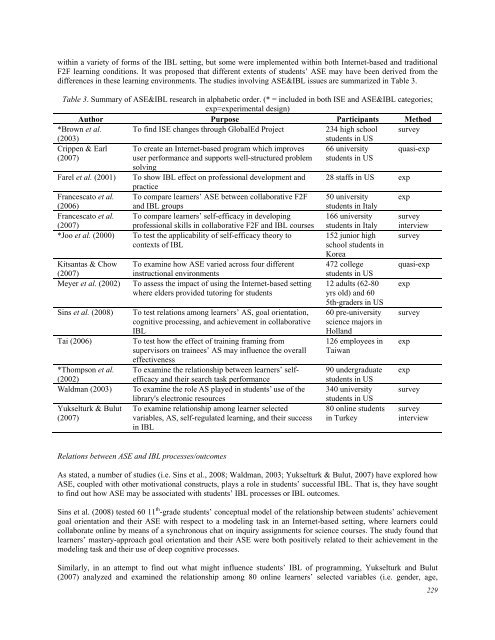October 2011 Volume 14 Number 4 - Educational Technology ...
October 2011 Volume 14 Number 4 - Educational Technology ...
October 2011 Volume 14 Number 4 - Educational Technology ...
You also want an ePaper? Increase the reach of your titles
YUMPU automatically turns print PDFs into web optimized ePapers that Google loves.
within a variety of forms of the IBL setting, but some were implemented within both Internet-based and traditional<br />
F2F learning conditions. It was proposed that different extents of students’ ASE may have been derived from the<br />
differences in these learning environments. The studies involving ASE&IBL issues are summarized in Table 3.<br />
Table 3. Summary of ASE&IBL research in alphabetic order. (* = included in both ISE and ASE&IBL categories;<br />
exp=experimental design)<br />
Author Purpose Participants Method<br />
*Brown et al. To find ISE changes through GlobalEd Project 234 high school survey<br />
(2003)<br />
students in US<br />
Crippen & Earl<br />
(2007)<br />
To create an Internet-based program which improves<br />
user performance and supports well-structured problem<br />
solving<br />
Farel et al. (2001) To show IBL effect on professional development and<br />
practice<br />
Francescato et al. To compare learners’ ASE between collaborative F2F<br />
(2006)<br />
and IBL groups<br />
Francescato et al. To compare learners’ self-efficacy in developing<br />
(2007)<br />
professional skills in collaborative F2F and IBL courses<br />
*Joo et al. (2000) To test the applicability of self-efficacy theory to<br />
contexts of IBL<br />
Kitsantas & Chow<br />
(2007)<br />
Meyer et al. (2002)<br />
To examine how ASE varied across four different<br />
instructional environments<br />
To assess the impact of using the Internet-based setting<br />
where elders provided tutoring for students<br />
Sins et al. (2008) To test relations among learners’ AS, goal orientation,<br />
cognitive processing, and achievement in collaborative<br />
IBL<br />
Tai (2006) To test how the effect of training framing from<br />
supervisors on trainees’ AS may influence the overall<br />
effectiveness<br />
*Thompson et al. To examine the relationship between learners’ self-<br />
(2002)<br />
efficacy and their search task performance<br />
Waldman (2003) To examine the role AS played in students’ use of the<br />
Yukselturk & Bulut<br />
(2007)<br />
library's electronic resources<br />
To examine relationship among learner selected<br />
variables, AS, self-regulated learning, and their success<br />
in IBL<br />
Relations between ASE and IBL processes/outcomes<br />
66 university<br />
students in US<br />
28 staffs in US exp<br />
50 university<br />
students in Italy<br />
166 university<br />
students in Italy<br />
152 junior high<br />
school students in<br />
Korea<br />
472 college<br />
students in US<br />
12 adults (62-80<br />
yrs old) and 60<br />
5th‐graders in US<br />
60 pre-university<br />
science majors in<br />
Holland<br />
126 employees in<br />
Taiwan<br />
90 undergraduate<br />
students in US<br />
340 university<br />
students in US<br />
80 online students<br />
in Turkey<br />
quasi-exp<br />
exp<br />
survey<br />
interview<br />
survey<br />
quasi-exp<br />
exp<br />
survey<br />
exp<br />
exp<br />
survey<br />
survey<br />
interview<br />
As stated, a number of studies (i.e. Sins et al., 2008; Waldman, 2003; Yukselturk & Bulut, 2007) have explored how<br />
ASE, coupled with other motivational constructs, plays a role in students’ successful IBL. That is, they have sought<br />
to find out how ASE may be associated with students’ IBL processes or IBL outcomes.<br />
Sins et al. (2008) tested 60 11 th -grade students’ conceptual model of the relationship between students’ achievement<br />
goal orientation and their ASE with respect to a modeling task in an Internet-based setting, where learners could<br />
collaborate online by means of a synchronous chat on inquiry assignments for science courses. The study found that<br />
learners’ mastery-approach goal orientation and their ASE were both positively related to their achievement in the<br />
modeling task and their use of deep cognitive processes.<br />
Similarly, in an attempt to find out what might influence students’ IBL of programming, Yukselturk and Bulut<br />
(2007) analyzed and examined the relationship among 80 online learners’ selected variables (i.e. gender, age,<br />
229

















